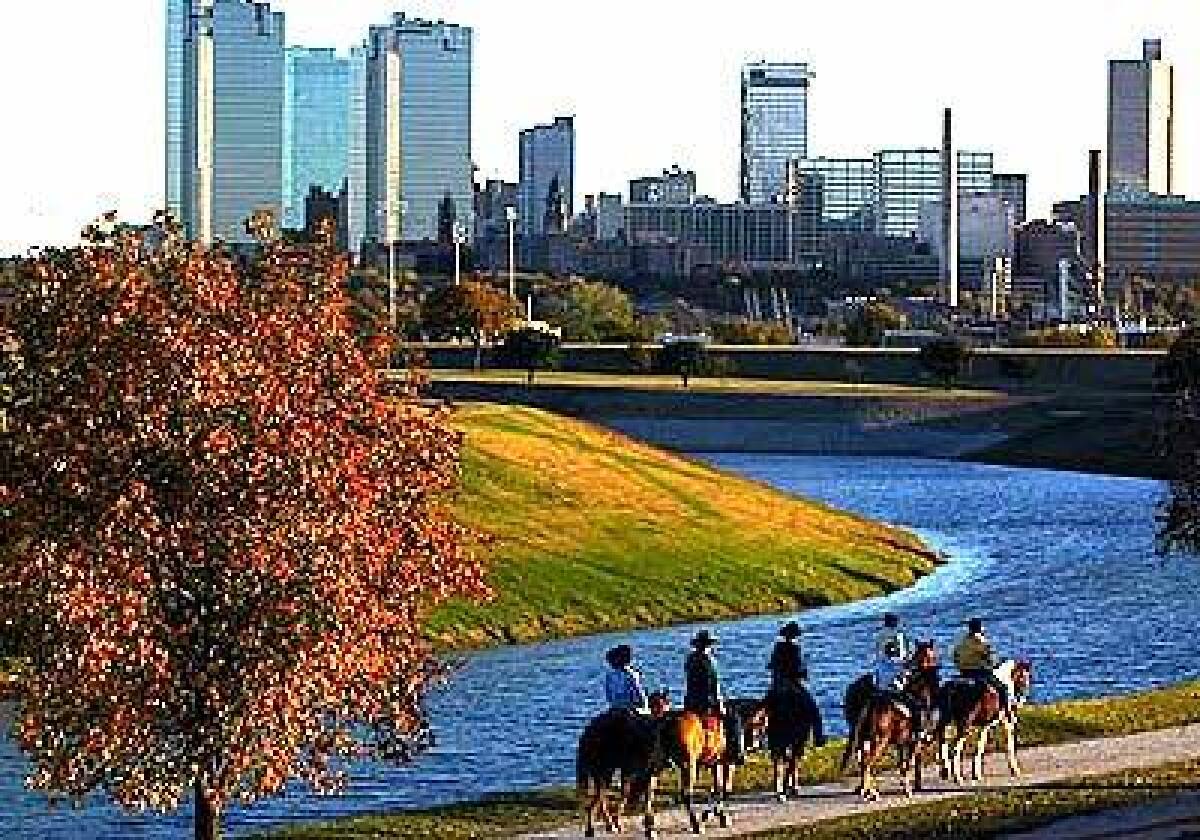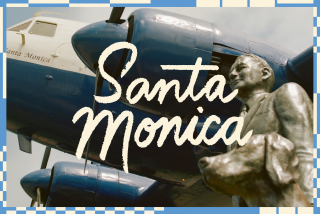The bonanza of Fort Worth

- Share via
Fort Worth — You probably don’t give much thought to Fort Worth when you fly into Dallas/Fort Worth International Airport. If you think about it at all, you may associate the town with cowboys, livestock and rodeos. And with good reason: Fort Worth residents are proud of their Western heritage. They even call their city Cowtown.
But you may not know that Fort Worth is a culture capital, with 14 museums, including a huge new contemporary art museum that was scheduled to open Saturday. In a city where oil money and philanthropy go hand in hand, its museums can and do buy some of the biggest and best art in the world. That’s a bonanza for visitors, especially considering that many Fort Worth museums don’t charge admission.
When I was here last month, friend Jorden Nye and I took advantage of the city’s multifaceted charms, from its cowboys to its culture.
We cheered as bull riders tried to stay aboard 1,800 pounds of wildly kicking fury; we yelled “yeehaw” when cowboys herded longhorn Texas steers through town; and we rubbed elbows with about 6,000 Willie Nelson fans as the country music icon performed at the world’s largest honky-tonk.
Then we visited the city’s cultural district for a preview of its new crown jewel: the Modern Art Museum of Fort Worth.
On Saturday the Modern was to open its new building to the public, becoming one of the largest contemporary art museums in the nation. The $65-million building, designed by internationally known Japanese architect Tadao Ando, holds an impressive collection of postwar art, ranging from mid-20th century Abstract Expressionism and Pop Art to new works in various media, including video and sound.
“These are the things you only see in books,” Jorden said when we visited.
Although the Modern is worth a visit on its own, it is but one of several significant cultural institutions. There are so many that the city calls itself the “museum capital of the Southwest.”
Some are small and regional, but others have notable claims to fame. Across the street from the new Modern is the Kimbell Art Museum, whose architecture and wide-ranging collections propel it to the fore as one of America’s best small museums. It was designed by 20th century architect Louis Kahn, a controversial but well-respected figure.
Nearby is the Ammon Carter Museum, whose large American art collection includes several hundred sculptures and paintings by Western artists Frederic Remington and Charles Russell; it also contains one of the nation’s largest photography collections.
Just around the corner is the new American Cowgirl Museum, a rootin’, tootin’ homage to the women who shaped the West.
And a few miles away in the downtown district is the striking Bass Performance Hall, one of the top opera houses in the world, according to Travel & Leisure magazine. It was designed by architect David M. Schwarz of Washington, D.C., in the classic European style and opened in 1998. Two 48-foot-tall trumpeting angels decorate the facade. Like other Fort Worth cultural institutions, including the Modern, the hall was built with private funds.
In fact, in the last 10 years Fort Worth residents have raised $285 million for new cultural institutions. A good chunk came from the billionaire Bass family, sometimes called the Medicis of Fort Worth, and from other key families and businesses, but many ordinary folks also donated.
“Some people think the words ‘cowboy’ and ‘culture’ don’t mix, but there’s no conflict,” said Douglas Harman, president of the Fort Worth Convention and Visitors Bureau. “People of the horse world love the West; they also enjoy visiting museums.”
Edward P. Bass, a member of the cattle- and oil-rich clan and the motivating force behind the construction of the performance hall, likes to talk about how Fort Worth celebrates its cow town roots. “Is it unique that we should pursue both high culture and popular heritage so passionately?” he asked. “First and foremost, we want Fort Worth to be a good place to live.
Ups and downs of downtown
The effort to make Fort Worth a good place to live accelerated about 20 years ago with the beginning of the renovation of downtown. A 20-block area was renamed Sundance Square after the Sundance Kid, who hid out here with buddy Butch Cassidy around the turn of the century.
The district has fine hotels, restaurants, shops, nightclubs and such only-in-Fort-Worth highlights as life-size topiary longhorn steers and a half-block-wide mural of a herd of cattle being driven along the Chisholm Trail, which once ran through downtown Fort Worth. There are redbrick streets, turn-of-the-century buildings and twinkling lights that line buildings and decorate trees and window frames.
But some of the bloom is off the rose in this area, once saluted as “Texas’ hottest downtown” by Texas Monthly magazine. It was hit by tornadoes two years ago that caused about $500 million in damage. The heavily damaged 35-story Bank One building still stands, its windows and doors shuttered. The building once housed offices and the Reata Restaurant, a local favorite that popularized the term “upscale cowboy cuisine.” The Reata has relocated nearby; its tortilla soup and beef dishes are standouts.
We stayed in the downtown district at the moderately priced Renaissance Worthington, a 12-story, 504-room hotel with spacious, nicely furnished rooms and a well-equipped exercise room and indoor pool. Nearby hotels range from the luxurious 38-room Ashton, with down pillows, comforters and Frette linens, to a Courtyard by Marriott, with simple rooms and weekend rates of less than $100 a night.
Fort Worth’s main tourist districts are its downtown; the cultural district, home to the city’s major museums; and Stockyards Station, a national historic district where visitors can get a realistic taste of the Old West.
From 1867 to 1872, more than 3 million head of cattle were driven up the Chisholm Trail from Fort Worth to Abilene, Kan. The drives are reenacted twice daily in the stockyards district. The cowboys are on the city payroll; so are the longhorns, which receive chow and a comfortable corral for their efforts.
Like many visitors, we took a walking tour of the area, stopped by the Stockyards Hotel (where bank robbers Bonnie and Clyde were once guests) and shopped in stores where we could buy a pair of silver-trimmed spurs for $42.95 or ostrich hide boots for $895.
Our next stockyards stop was the Cattlemen’s Steakhouse, a local institution where we saw ‘50s-era photos of blue-ribbon steers on the wall and were served thick and juicy charbroiled steaks. Another good place to dine in the district is Joe T. Garcia’s, also an institution. Garcia’s can seat 1,600 at its sprawling indoor-outdoor Tex-Mex restaurant.
Diners have two choices: fajitas ($10.50) or a huge enchilada-taco plate ($9.25). We were seated next to Ando, the Modern’s architect, the night we visited, and he seemed to enjoy his food as much as we enjoyed ours.
From haute to honky-tonk
There’s much to do in the daytime in the stockyards district, but the area really comes alive at night. Saloons and clubs line Exchange Street, the main drag. And then, of course, there’s Billy Bob’s Texas, a nightclub/bull-riding venue/honky-tonk. We moseyed down to Billy Bob’s our first night in town. Covering 100,000 square feet, the club is so huge that it holds an indoor rodeo arena, a dance floor, restaurants, a showroom, bars, a saloon and a dry goods store.
Out on the dance floor, we saw women with straight hair, tight jeans and tall boots gracefully two-stepping with men in western hats, plaid shirts and equally tight jeans. Above their heads, a mirrored saddle turned slowly, throwing slivers of light across the room. “That works better for us than a mirrored ball,” said manager Marty Travis. The saddle is a prop from “Rhinestone,” a 1984 film with Dolly Parton and Sylvester Stallone.
If you get to Billy Bob’s before the main act -- Willie Nelson was there when we visited -- you can stop by the arena to watch professional rodeo cowboys participate in bull riding, often called the world’s most dangerous sport. The action is explosive and breathtaking.
Between riders, I chatted with cowboy Kent Cox, 31, a retired bull rider who lost an eye some years ago when a bull crushed the side of his face, requiring five surgeries and 13 aluminum plates. “I miss it sometimes,” he said nostalgically.
Rodeo is a highlight for many Fort Worth visitors. There are championship competitions, including barrel racing, bronc riding and calf roping, Fridays and Saturdays at the indoor Cowtown Coliseum in the stockyards district. Major equestrian competitions, such as the Fort Worth Stock Show and Rodeo (Jan. 11 to Feb. 7), are held across town at Will Rogers Memorial Center in the cultural district.
Yes, the cultural district has horses.
“That’s one of the fine things about our city,” said Harman of the convention bureau. “One moment you can be in Kimbell Museum and the next moment you can walk across the street and see a cutting-horse show.”
We spent two days exploring the cultural district’s museums and could have spent more. Jorden, an avid collector, was particularly interested in the Modern’s works. Nearly 100 pieces, estimated at $40 million to $60 million, were acquired for the opening.
The 153,000-square-foot glass-and-concrete building seems to float on the large reflecting pool it faces. Diffused or deflected light is everywhere. This first large-scale U.S. commission for architect Ando is a work of art on its own.
I asked chief curator Michael Auping for a list of the five crown jewels of the collection. He began with “Vortex 2002,” a soaring 230-ton steel sculpture by Richard Serra.
The 67-foot-tall work stands outside, at the southwest corner of the museum. He also mentioned Andy Warhol’s “Twenty-five Colored Marilyns,” Francis Bacon’s “Self-Portrait,” Anselm Kiefer’s “Quaternity” and Gerhard Richter’s “Seascape.”
Much as I enjoyed the Modern, another stop in the district also left a lasting impression: the wild and woolly Cowgirl Museum and National Hall of Fame.
The three main galleries in this light-filled building are devoted to ranch women; Hollywood types, such as Dale Evans and Barbara Stanwyck; and champion cowgirls, from shooting ace Annie Oakley to jockey Julie Krone, who won the Belmont Stakes in 1993 to become the first woman to win a Triple Crown race. There are trick riders and ropers, country crooners and lots of glitzy costumes and props.
There’s also a host of fun interactive exhibits. Kids -- or adults -- can saddle a horse, interview a cowgirl via an interactive computer or become the star in a Wild West movie poster.
If you’re really bold, you can ride a bronc in a rodeo and be filmed doing it. The museum posts your film on the Internet.
OK, it’s not a real bronc; it’s mechanical. And you’re not really in a rodeo. It’s rodeo footage playing on a screen behind you. But the filming part is true.
Yeehaw. I’m an Internet rodeo cowgirl. And richer, too, for the museums I visited.
More about Fort Worth, a crossroads of the Texas lifestyle
GETTING THERE:
From LAX, nonstop service to Dallas/Fort Worth is available on American, Delta and United, and connecting service (change of planes) is offered on America West, Continental, Northwest and Frontier. Restricted round-trip fares begin at $350.
WHERE TO STAY:
Ashton Hotel, 610 Main St., Fort Worth, TX 76102; (866) 327-4866, www.theashtonhotel.com. Housed in historic buildings in Sundance Square, the Ashton has 38 deluxe king-bedded rooms. Rates begin at $250 a night, but be sure to ask for specials.
Blackstone Courtyard by Marriott, 601 Main St., Fort Worth 76102; (800) 321-2211 or (817) 885-8700, www.courtyard.com. Convenient downtown location. Rooms are simple in this renovated historic building. Heated outdoor pool. Doubles from $99 (on weekends) to $145.
Renaissance Worthington, 200 Main St., Fort Worth 76102; (800) 433-5677 or (817) 870-1000, www.renaissancehotels.com. Large, comfortable downtown hotel with all amenities. Doubles $159-$165; ask if lower rates are available.
WHERE TO EAT:
Cattlemen’s Steakhouse, 2458 N. Main St., Fort Worth; (817) 624-3945, www.cattlemenssteakhouse.com. The ambience is pure ‘50s-style dining room, but the steaks are excellent. Entrees range between $10.95-$30.95.
Joe T. Garcia’s Mexican Dishes, 2201 N. Commerce St.; (817) 626-4356, www.joets.com. Follow the crowds to Joe T.’s for fast service and plentiful portions. If you’re there during warm weather, dine outside in the expansive gardens. Entrees $9.25, $10.50.
Reata Restaurant, 310 Houston St.; (817) 336-1009, www.reata.com. Upscale Southwestern cuisine with a Texas flair. Creative Tex-Mex and beef dishes. Entrees $14.95-$29.95.
TO LEARN MORE:
Fort Worth Convention and Visitors Bureau, 415 Throckmorton St., Fort Worth 76102; (800) 433-5747, www.fortworth.com.
Texas Department of Economic Development, Tourism Division, P.O. Box 12728, Austin, TX 78711-2728; (800) 888-8TEX (888-8839), www.travel tex.com.
*
Rosemary McClure is an editor in the Travel section.
More to Read
Sign up for The Wild
We’ll help you find the best places to hike, bike and run, as well as the perfect silent spots for meditation and yoga.
You may occasionally receive promotional content from the Los Angeles Times.






